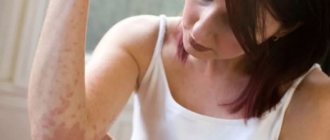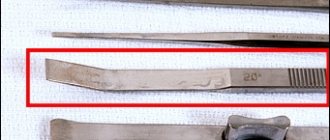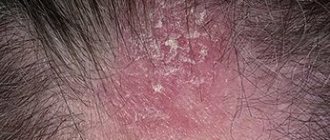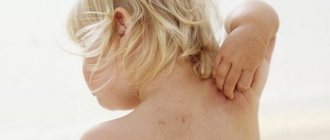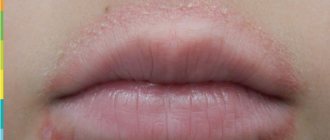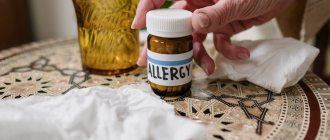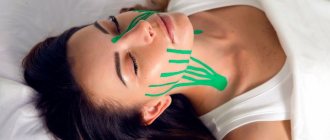Other diseases starting with the letter “D”: Dacryocystitis, Farsightedness, Color blindness, DIC, Bicornuate uterus, Dementia, Allergic dermatitis, Depression, Atopic dermatitis, Perioral dermatitis, Dermatitis, Diabetic neuropathy, Diabetic retinopathy, Diabetic foot, Diarrhea, Diathesis, Diverticulosis colon, Dermatophilia. Diaper dermatitis. Contact dermatitis.
People susceptible to allergic diseases may notice scaly rashes around the mouth. This disease has a medical name - rosacea-like or perioral dermatitis. Peeling of the eyelids and skin around the eyes (periorbital) is more rare.
Causes of the disease
Perioral dermatitis may appear for the following reasons:
- use of low-quality cosmetics on the face;
- the presence of infectious diseases in chronic or acute form;
- use of ointments with corticosteroids;
- hormonal imbalances caused by various reasons;
- disturbances in the functioning of the gastrointestinal tract;
- toothpastes containing fluoride.
Allergies on the face and neck
If it is confirmed that it was allergies on the face and neck that caused the redness and rashes, the allergen will be identified. More often such rashes are provoked by:
- Food;
- Seasonal flowering of plants, pollen;
- Cosmetics for face and neck care;
- Contaminated air;
- Medicines, etc.
Allergy on the chin
If, after diagnosis, the doctor determines that your redness is an allergy on the chin, and not another type of disease, then the allergen will be identified and appropriate therapy will be prescribed. But often a small red rash on the chin indicates hormonal changes in the body. Therefore, such rashes occur:
- In adolescents - during the formation of the hormonal system;
- In adults after 45 years, when restructuring of the body also begins and hormonal levels change.
Then it will be enough to take a blood test for hormones, and the doctor will determine the true cause of the spots on the face.
Allergic acne on forehead
When red spots appear on the forehead, doctors can diagnose:
- Diseases of the small intestine - in the central part of the forehead;
- Adrenal glands - near the eyebrows;
- Rectum - on the left side of the forehead;
- Large intestine - at the top, near the hair;
- Bladder - at the temples;
- Endocrine and hormonal systems - small rash in any area of the forehead;
- The nervous system is a large red spot.
If allergic acne on the forehead is determined after examination, then the treatment regimen is the same:
- Identification of the main allergen;
- Its elimination;
- Prescription of the treatment complex.
You don’t have to wonder why you have a rash on your face, you just need to come to the Allergomed clinic, where they will definitely help you get rid of them.
Treatment methods
The method of treatment for perioral dermatitis is determined by the attending physician. The duration of treatment may take a calendar month.
Basic recommendations for treatment methods:
- temporary but complete refusal to use cosmetics on the face;
- exclude the use of ointments containing corticosteroids;
- additional moisturizing of the facial skin is required;
- in sunny weather, you should protect your skin from exposure to ultraviolet rays as much as possible;
- try to eat foods containing hot and salty seasonings as little as possible;
- a doctor may prescribe electrolysis of diseased skin areas;
- in some cases, the patient is sent for cryomassage using liquid nitrogen;
- Antibiotics or medications from the imidazole group may be prescribed;
- the patient should start taking vitamins B6, niacin and riboflavin.
In some cases, observation at a dispensary may be required.
How to remove acne* on the chin: using Clindovit® gel
Acne is a chronic disease that cannot be completely cured. The risk of relapse always remains [18]. For mild to moderate acne, Clindovit® gel can be used [6, 18]. It contains clindamycin phosphate [6]. It is an antibiotic that exhibits antimicrobial activity against propionibacteria [6]. Also, after applying Clindovit® gel to the skin, the level of free fatty acids decreases from approximately 14% to 2% [6]. The drug must be used regularly, applied to the skin 2-3 times a day [6].
*acne
Preventive measures
The key preventive measures to prevent the development of perioral dermatitis are:
- protection of facial skin from exposure to sunlight;
- maintaining proper nutrition with minimal consumption of hot and salty seasonings;
- minimizing skin dryness;
- use high-quality cosmetics from trusted manufacturers.
Although perioral dermatitis does not pose a health threat, treatment is necessary.
Clinical manifestations
Localization : has a characteristic location of the rashes, these are the perioral zone, nasolabial folds, skin of the chin and cheeks. The affected areas are characterized by symmetry.
Characteristic sign : a strip of healthy skin around the lips measuring 2-4 mm (characteristic in most cases, however, the case shown in the photo is a rare exception).
Rashes : pinkish-red papules, papulo-vesicles and papulo-pustules measuring 1-2 mm are located on an erythematous (red) background. Rashes are resolved by the appearance of crusts in place of the papules. The skin is dry, swollen.
Subjective sensations: characterized by a feeling of skin tightness, itching and burning.
Outbreaks of erythema with temperature changes, alcohol intake, spicy and hot foods. These manifestations are also characteristic of rosacea, which complicates the diagnosis of perioral dermatitis.
pigmentation may develop .
Diagnostic features
Before talking about therapy, the doctor will definitely give a referral for examination of the child. The purpose of diagnosis is to confirm the presence of an allergy and determine the substance that provoked such a reaction. The examination will consist of the following stages:
- taking an anamnesis - the doctor must find out what potential allergens the child has been in contact with recently, he is also interested in whether there are any allergies in the baby's family - in this case, the tendency to allergies will be quite high;
- laboratory blood tests, their task is to determine the level of immunoglobulin E. This protein is responsible for the development of an allergic reaction and its intensity;
- allergy tests - they allow you to determine which substance caused the child’s allergy, and accordingly, increase the effectiveness of further treatment.
Once the diagnosis is complete, treatment will be prescribed. It is usually represented by a comprehensive program with high results.
Atopic dermatitis around the eyes
array ( 'ID' => '8465', '~ID' => '8465', 'NAME' => 'Atopic dermatitis around the eyes', '~NAME' => 'Atopic dermatitis around the eyes', 'IBLOCK_ID' = > '43', '~IBLOCK_ID' => '43', 'IBLOCK_SECTION_ID' => '1185', '~IBLOCK_SECTION_ID' => '1185', 'DETAIL_TEXT' => ' Atopic dermatitis around the eyes
is in most cases a hereditary disease and appears at an early age.Symptoms: dry, reddened skin, swelling around the eyes, weeping blisters that burst, dry out, form crusts and crack.All this is accompanied by very severe itching.
The disease is chronic.
The causes are external and internal. External reactions include: allergic reactions to food, plant pollen, animal fur, and some medications. Trauma to the skin of the eyelids may also be the cause. Internal causes - diseases of the stomach and intestines, worms, improper metabolism. Atopic dermatitis usually appears on the eyelids of one eye. For proper treatment of atopic dermatitis in adults and children,
it is necessary to identify the allergen that affects the occurrence of the disease and eliminate it.
After this, therapy can begin. First of all, dietary adjustments are necessary: spicy, sweet, citrus fruits, cow's milk - absolutely not. Completely stop using cosmetics. Wash inflamed areas only with running water without hygiene products. After stopping the disease, use only hypoallergenic cosmetics for makeup. In order to remove inflammation, apply eye lotions with antiseptic drugs (fucorcin, potassium permanganate, etc.). Weeping rashes are treated with a solution of furatsilin or potassium permanganate, lubricated with ichthyol, sulfur or tar ointment. If the skin is severely inflamed and cracked, and the patient experiences unbearable itching, then methylprednisolone, fluocinolone, fluorocort and others are used. The most effective is considered to be an ointment with the addition of an antibiotic - geocortone. Allergic inflammation is treated with antihistamines. If atopic dermatitis is accompanied by a nervous disorder, the doctor should prescribe antihistamines, which have a sedative effect. This will also reduce severe itching. To reduce inflammation, salicylates, for example, were requested. Also, to stabilize the patient’s condition, it is recommended to take a calcium chloride solution orally for ten days. You can use drugs in the form of drops (for example, prednisolone solution). In order to relieve swelling from the eyes with atopic dermatitis,
hormonal ointments of the corticosteroid group, such as hydrocortisone, are used, but these drugs have side effects, so you should consult your doctor before use.
In complex therapy, folk remedies give good results: compresses with herbs, for example, medicinal chamomile, a decoction of string, grated fresh pumpkin. Atopic dermatitis
can also occur
under the eyes of a child.
In this case, consult a doctor immediately.
The disease is very long and difficult to treat. A diet, constant moisturizing of the skin around the eyes, and drug treatment are required. ', '~DETAIL_TEXT' => ' Atopic dermatitis around the eyes
is in most cases a hereditary disease and appears at an early age.
Symptoms: dry, reddened skin, swelling around the eyes, weeping blisters that burst, dry out, form crusts and crack. All this is accompanied by very severe itching. The disease is chronic. The causes are external and internal. External reactions include: allergic reactions to food, plant pollen, animal fur, and some medications. Trauma to the skin of the eyelids may also be the cause. Internal causes - diseases of the stomach and intestines, worms, improper metabolism. Atopic dermatitis usually appears on the eyelids of one eye. For proper treatment of atopic dermatitis in adults and children,
it is necessary to identify the allergen that affects the occurrence of the disease and eliminate it.
After this, therapy can begin. First of all, dietary adjustments are necessary: spicy, sweet, citrus fruits, cow's milk - absolutely not. Completely stop using cosmetics. Wash inflamed areas only with running water without hygiene products. After stopping the disease, use only hypoallergenic cosmetics for makeup. In order to remove inflammation, apply eye lotions with antiseptic drugs (fucorcin, potassium permanganate, etc.). Weeping rashes are treated with a solution of furatsilin or potassium permanganate, and lubricated with ichthyol, sulfur or tar ointment. If the skin is severely inflamed and cracked, and the patient experiences unbearable itching, then methylprednisolone, fluocinolone, fluorocort and others are used. The most effective is considered to be an ointment with the addition of an antibiotic - geocortone. Allergic inflammation is treated with antihistamines. If atopic dermatitis is accompanied by a nervous disorder, the doctor should prescribe antihistamines, which have a sedative effect. This will also reduce severe itching. To reduce inflammation, salicylates, for example, were requested. Also, to stabilize the patient’s condition, it is recommended to take a calcium chloride solution orally for ten days. You can use drugs in the form of drops (for example, prednisolone solution). In order to relieve swelling from the eyes with atopic dermatitis,
hormonal ointments of the corticosteroid group, such as hydrocortisone, are used, but these drugs have side effects, so you should consult your doctor before use.
In complex therapy, folk remedies give good results: compresses with herbs, for example, medicinal chamomile, a decoction of string, grated fresh pumpkin. Atopic dermatitis
can also occur
under the eyes of a child. In this case, consult a doctor immediately. The disease is very long and difficult to treat. A diet, constant moisturizing of the skin around the eyes, and drug treatment are required. ', 'DETAIL_TEXT_TYPE' => 'html', '~DETAIL_TEXT_TYPE' => 'html', 'PREVIEW_TEXT' => 'Atopic dermatitis around the eyes is in most cases a hereditary disease and appears at an early age. Symptoms: dry, reddened skin, swelling around the eyes, weeping blisters that burst, dry out, form crusts and crack. All this is accompanied by very severe itching.', '~PREVIEW_TEXT' => 'Atopic dermatitis around the eyes in most cases is a hereditary disease and manifests itself at an early age. Symptoms: dry, reddened skin, swelling around the eyes, weeping blisters that burst, dry out, form crusts and crack. All this is accompanied by very severe itching.', 'PREVIEW_TEXT_TYPE' => 'text', '~PREVIEW_TEXT_TYPE' => 'text', 'DETAIL_PICTURE' => NULL, '~DETAIL_PICTURE' => NULL, 'TIMESTAMP_X' => '03.02 .2021 00:19', '~TIMESTAMP_X' => '02/03/2021 00:19', 'ACTIVE_FROM' => NULL, '~ACTIVE_FROM' => NULL, 'LIST_PAGE_URL' => '/forpatients/school/info/ ', '~LIST_PAGE_URL' => '/forpatients/school/info/', 'DETAIL_PAGE_URL' => '/forpatients/school/info/atopicheskiy-dermatit/atopicheskiy-dermatit-vokrug-glaz/', '~DETAIL_PAGE_URL' = > '/forpatients/school/info/atopicheskiy-dermatit/atopicheskiy-dermatit-vokrug-glaz/', 'LANG_DIR' => '/', '~LANG_DIR' => '/', 'CODE' => 'atopicheskiy- dermatit-vokrug-glaz', '~CODE' => 'atopicheskiy-dermatit-vokrug-glaz', 'EXTERNAL_ID' => '8465', '~EXTERNAL_ID' => '8465', 'IBLOCK_TYPE_ID' => 'SERVICE' , '~IBLOCK_TYPE_ID' => 'SERVICE', 'IBLOCK_CODE' => ", '~IBLOCK_CODE' => ", 'IBLOCK_EXTERNAL_ID' => ", '~IBLOCK_EXTERNAL_ID' => ", 'LID' => 's1', '~LID' => 's1', 'NAV_RESULT' => false, 'DISPLAY_ACTIVE_FROM' => ", 'IPROPERTY_VALUES' => array ( 'ELEMENT_META_TITLE' => 'Dermatitis around the eyes - causes and treatment of atopic dermatitis of the eyelids', ' ELEMENT_META_DESCRIPTION' => 'Atopic dermatitis around the eyes is in most cases a hereditary disease and appears at an early age. Symptoms: dry, reddened skin, swelling around the eyes, weeping blisters that burst, dry out, form crusts and crack. All this is accompanied by very severe itching.', 'SECTION_DETAIL_PICTURE_FILE_ALT' => 'Atopic dermatitis around the eyes', 'ELEMENT_PREVIEW_PICTURE_FILE_ALT' => 'Atopic dermatitis around the eyes', 'ELEMENT_DETAIL_PICTURE_FILE_ALT' => 'Atopic dermatitis around the eyes', ), 'FIELDS' => array ( ), 'PROPERTIES' => array ( 'IMAGES' => array ( 'ID' => '240', 'TIMESTAMP_X' => '2017-11-15 09:11:27', 'IBLOCK_ID' => '43', 'NAME' => 'Photo gallery', 'ACTIVE' => 'Y', 'SORT' => '500', 'CODE' => 'IMAGES', 'DEFAULT_VALUE' => ", ' PROPERTY_TYPE' => 'F', 'ROW_COUNT' => '1', 'COL_COUNT' => '30', 'LIST_TYPE' => 'L', 'MULTIPLE' => 'Y', 'XML_ID' => » , 'FILE_TYPE' => 'jpg, gif, bmp, png, jpeg', 'MULTIPLE_CNT' => '5', 'TMP_ID' => NULL, 'LINK_IBLOCK_ID' => '0', 'WITH_DESCRIPTION' => 'Y ', 'SEARCHABLE' => 'N', 'FILTRABLE' => 'N', 'IS_REQUIRED' => 'N', 'VERSION' => '1', 'USER_TYPE' => NULL, 'USER_TYPE_SETTINGS' => NULL, 'HINT' => ", 'PROPERTY_VALUE_ID' => false, 'VALUE' => false, 'DESCRIPTION' => false, 'VALUE_ENUM' => NULL, 'VALUE_XML_ID' => NULL, 'VALUE_SORT' => NULL , '~VALUE' => false, '~DESCRIPTION' => false, '~NAME' => 'Photo gallery', '~DEFAULT_VALUE' => "), 'BLOCK_EXP' => array ( 'ID' => ' 241', 'TIMESTAMP_X' => '2017-11-15 09:11:27', 'IBLOCK_ID' => '43', 'NAME' => 'Sharing experience', 'ACTIVE' => 'Y', ' SORT' => '500', 'CODE' => 'BLOCK_EXP', 'DEFAULT_VALUE' => array ( 'TYPE' => 'HTML', 'TEXT' => "), 'PROPERTY_TYPE' => 'S' , 'ROW_COUNT' => '1', 'COL_COUNT' => '30', 'LIST_TYPE' => 'L', 'MULTIPLE' => 'N', 'XML_ID' => ", 'FILE_TYPE' => " , 'MULTIPLE_CNT' => '5', 'TMP_ID' => NULL, 'LINK_IBLOCK_ID' => '0', 'WITH_DESCRIPTION' => 'N', 'SEARCHABLE' => 'N', 'FILTRABLE' => ' N', 'IS_REQUIRED' => 'N', 'VERSION' => '1', 'USER_TYPE' => 'HTML', 'USER_TYPE_SETTINGS' => array ( 'height' => 400, ), 'HINT' = > ", 'PROPERTY_VALUE_ID' => '20709', 'VALUE' => array ( 'TEXT' => 'Children are prescribed enterosgel, activated charcoal, and antihistamines. For severe itching, sedatives (glycine, persen, peony tincture). To normalize the functioning of the gastrointestinal tract - mezim or festal. Hormonal drugs for the treatment of children are used only as prescribed by a doctor for no more than five days.', 'TYPE' => 'HTML', ), 'DESCRIPTION' => ", 'VALUE_ENUM' => NULL, 'VALUE_XML_ID' => NULL, ' VALUE_SORT' => NULL, '~VALUE' => array ( 'TEXT' => 'Children are prescribed enterosgel, activated carbon, antihistamines. For severe itching, sedatives (glycine, persen, peony tincture). To normalize the gastrointestinal tract - mezim or festal. Hormonal drugs for the treatment of children are used only as prescribed by a doctor for no more than five days.', 'TYPE' => 'HTML', ), '~DESCRIPTION' => ", '~NAME' => 'Sharing experience' , '~DEFAULT_VALUE' => array ( 'TYPE' => 'HTML', 'TEXT' => " ), ), 'BLOCK_VIDEO' => array ( 'ID' => '242', 'TIMESTAMP_X' => '2017-11-15 10:20:07', 'IBLOCK_ID' => '43', 'NAME' => 'Youtube Video', 'ACTIVE' => 'Y', 'SORT' => '500', 'CODE' => 'BLOCK_VIDEO', 'DEFAULT_VALUE' => array ( 'TEXT' => ", 'TYPE' => 'HTML', ), 'PROPERTY_TYPE' => 'S', 'ROW_COUNT' => '1 ', 'COL_COUNT' => '50', 'LIST_TYPE' => 'L', 'MULTIPLE' => 'N', 'XML_ID' => ", 'FILE_TYPE' => ", 'MULTIPLE_CNT' => '5 ', 'TMP_ID' => NULL, 'LINK_IBLOCK_ID' => '0', 'WITH_DESCRIPTION' => 'N', 'SEARCHABLE' => 'N', 'FILTRABLE' => 'N', 'IS_REQUIRED' => 'N', 'VERSION' => '1', 'USER_TYPE' => 'HTML', 'USER_TYPE_SETTINGS' => array ( 'height' => 200, ), 'HINT' => ", 'PROPERTY_VALUE_ID' => NULL, 'VALUE' => ", 'DESCRIPTION' => ", 'VALUE_ENUM' => NULL, 'VALUE_XML_ID' => NULL, 'VALUE_SORT' => NULL, '~VALUE' => ", '~DESCRIPTION' = > ", '~NAME' => 'Youtube Video', '~DEFAULT_VALUE' => array ( 'TEXT' => ", 'TYPE' => 'HTML', ), ), 'BLOCK_VIDEO_DESC' => array ( ' ID' => '243', 'TIMESTAMP_X' => '2017-11-15 09:11:27', 'IBLOCK_ID' => '43', 'NAME' => 'Video description', 'ACTIVE' => 'Y', 'SORT' => '500', 'CODE' => 'BLOCK_VIDEO_DESC', 'DEFAULT_VALUE' => array ( 'TYPE' => 'HTML', 'TEXT' => "), 'PROPERTY_TYPE' => 'S', 'ROW_COUNT' => '1', 'COL_COUNT' => '30', 'LIST_TYPE' => 'L', 'MULTIPLE' => 'N', 'XML_ID' => ", ' FILE_TYPE' => ", 'MULTIPLE_CNT' => '5', 'TMP_ID' => NULL, 'LINK_IBLOCK_ID' => '0', 'WITH_DESCRIPTION' => 'N', 'SEARCHABLE' => 'N', ' FILTRABLE' => 'N', 'IS_REQUIRED' => 'N', 'VERSION' => '1', 'USER_TYPE' => 'HTML', 'USER_TYPE_SETTINGS' => array ( 'height' => 400, ) , 'HINT' => ", 'PROPERTY_VALUE_ID' => NULL, 'VALUE' => ", 'DESCRIPTION' => ", 'VALUE_ENUM' => NULL, 'VALUE_XML_ID' => NULL, 'VALUE_SORT' => NULL, '~VALUE' => ", '~DESCRIPTION' => ", '~NAME' => 'Video description', '~DEFAULT_VALUE' => array ( 'TYPE' => 'HTML', 'TEXT' => " , ), ), 'BLOCK_TEXT_BOTTOM' => array ( 'ID' => '244', 'TIMESTAMP_X' => '2017-11-15 09:11:27', 'IBLOCK_ID' => '43', 'NAME ' => 'Text block at the bottom of the page', 'ACTIVE' => 'Y', 'SORT' => '500', 'CODE' => 'BLOCK_TEXT_BOTTOM', 'DEFAULT_VALUE' => array ( 'TYPE' => ' HTML', 'TEXT' => "), 'PROPERTY_TYPE' => 'S', 'ROW_COUNT' => '1', 'COL_COUNT' => '30', 'LIST_TYPE' => 'L', 'MULTIPLE ' => 'N', 'XML_ID' => ", 'FILE_TYPE' => ", 'MULTIPLE_CNT' => '5', 'TMP_ID' => NULL, 'LINK_IBLOCK_ID' => '0', 'WITH_DESCRIPTION' = > 'N', 'SEARCHABLE' => 'N', 'FILTRABLE' => 'N', 'IS_REQUIRED' => 'N', 'VERSION' => '1', 'USER_TYPE' => 'HTML', 'USER_TYPE_SETTINGS' => array ( 'height' => 400, ), 'HINT' => ", 'PROPERTY_VALUE_ID' => NULL, 'VALUE' => ", 'DESCRIPTION' => ", 'VALUE_ENUM' => NULL , 'VALUE_XML_ID' => NULL, 'VALUE_SORT' => NULL, '~VALUE' => ", '~DESCRIPTION' => ", '~NAME' => 'Text block at the bottom of the page', '~DEFAULT_VALUE' => array ( 'TYPE' => 'HTML', 'TEXT' => ", ), 'AMP' => array ( 'ID' => '305', 'TIMESTAMP_X' => '2021-03-01 22 :23:44', 'IBLOCK_ID' => '43', 'NAME' => 'AMP', 'ACTIVE' => 'Y', 'SORT' => '500', 'CODE' => 'AMP' , 'DEFAULT_VALUE' => ", 'PROPERTY_TYPE' => 'S', 'ROW_COUNT' => '1', 'COL_COUNT' => '30', 'LIST_TYPE' => 'L', 'MULTIPLE' => ' N', 'XML_ID' => ", 'FILE_TYPE' => ", 'MULTIPLE_CNT' => '5', 'TMP_ID' => NULL, 'LINK_IBLOCK_ID' => '0', 'WITH_DESCRIPTION' => 'N' , 'SEARCHABLE' => 'N', 'FILTRABLE' => 'N', 'IS_REQUIRED' => 'N', 'VERSION' => '1', 'USER_TYPE' => NULL, 'USER_TYPE_SETTINGS' => NULL , 'HINT' => ", 'PROPERTY_VALUE_ID' => NULL, 'VALUE' => ", 'DESCRIPTION' => ", 'VALUE_ENUM' => NULL, 'VALUE_XML_ID' => NULL, 'VALUE_SORT' => NULL, '~VALUE' => ", '~DESCRIPTION' => ", '~NAME' => 'AMP', '~DEFAULT_VALUE' => ", ), ), 'DISPLAY_PROPERTIES' => array ( 'BLOCK_EXP' => array ( 'ID' => '241', 'TIMESTAMP_X' => '2017-11-15 09:11:27', 'IBLOCK_ID' => '43', 'NAME' => 'Sharing experience', 'ACTIVE ' => 'Y', 'SORT' => '500', 'CODE' => 'BLOCK_EXP', 'DEFAULT_VALUE' => array ( 'TYPE' => 'HTML', 'TEXT' => ", ), 'PROPERTY_TYPE' => 'S', 'ROW_COUNT' => '1', 'COL_COUNT' => '30', 'LIST_TYPE' => 'L', 'MULTIPLE' => 'N', 'XML_ID' => ", 'FILE_TYPE' => ", 'MULTIPLE_CNT' => '5', 'TMP_ID' => NULL, 'LINK_IBLOCK_ID' => '0', 'WITH_DESCRIPTION' => 'N', 'SEARCHABLE' => 'N ', 'FILTRABLE' => 'N', 'IS_REQUIRED' => 'N', 'VERSION' => '1', 'USER_TYPE' => 'HTML', 'USER_TYPE_SETTINGS' => array ( 'height' => 400, ), 'HINT' => ", 'PROPERTY_VALUE_ID' => '20709', 'VALUE' => array ( 'TEXT' => 'Children are prescribed enterosgel, activated carbon, antihistamines. For severe itching, sedatives (glycine, persen, peony tincture). To normalize the functioning of the gastrointestinal tract - mezim or festal. Hormonal drugs for the treatment of children are used only as prescribed by a doctor for no more than five days.', 'TYPE' => 'HTML', ), 'DESCRIPTION' => ", 'VALUE_ENUM' => NULL, 'VALUE_XML_ID' => NULL, ' VALUE_SORT' => NULL, '~VALUE' => array ( 'TEXT' => 'Children are prescribed enterosgel, activated carbon, antihistamines. For severe itching, sedatives (glycine, persen, peony tincture). To normalize the gastrointestinal tract - mezim or festal. Hormonal drugs for the treatment of children are used only as prescribed by a doctor for no more than five days.', 'TYPE' => 'HTML', ), '~DESCRIPTION' => ", '~NAME' => 'Sharing experience' , '~DEFAULT_VALUE' => array ( 'TYPE' => 'HTML', 'TEXT' => "), 'DISPLAY_VALUE' => 'Children are prescribed enterosgel, activated charcoal, and antihistamines. For severe itching, sedatives (glycine, persen, peony tincture). To normalize the functioning of the gastrointestinal tract - mezim or festal. Hormonal drugs for the treatment of children are used only as prescribed by a doctor for no more than five days.', ), ), 'IBLOCK' => array ( 'ID' => '43', '~ID' => '43', 'TIMESTAMP_X' => '10.10.2021 23:51', '~TIMESTAMP_X' => '10.10.2021 23:51', 'IBLOCK_TYPE_ID' => 'SERVICE', '~IBLOCK_TYPE_ID' => 'SERVICE', 'LID' => 's1', '~LID' => 's1', 'CODE' => ", '~CODE' => ", 'API_CODE' => NULL, '~API_CODE' => NULL, 'NAME' => ' Information for patients', '~NAME' => 'Information for patients', 'ACTIVE' => 'Y', '~ACTIVE' => 'Y', 'SORT' => '500', '~SORT' = > '500', 'LIST_PAGE_URL' => '/forpatients/school/info/', '~LIST_PAGE_URL' => '/forpatients/school/info/', 'DETAIL_PAGE_URL' => '#SITE_DIR#/forpatients/school/ info/#SECTION_CODE_PATH#/#ELEMENT_CODE#/', '~DETAIL_PAGE_URL' => '#SITE_DIR#/forpatients/school/info/#SECTION_CODE_PATH#/#ELEMENT_CODE#/', 'SECTION_PAGE_URL' => '#SITE_DIR#/forpatients /school/info/#SECTION_CODE_PATH#/', '~SECTION_PAGE_URL' => '#SITE_DIR#/forpatients/school/info/#SECTION_CODE_PATH#/', 'PICTURE' => NULL, '~PICTURE' => NULL, ' DESCRIPTION' => ", '~DESCRIPTION' => ", 'DESCRIPTION_TYPE' => 'text', '~DESCRIPTION_TYPE' => 'text', 'RSS_TTL' => '24', '~RSS_TTL' => '24 ', 'RSS_ACTIVE' => 'Y', '~RSS_ACTIVE' => 'Y', 'RSS_FILE_ACTIVE' => 'N', '~RSS_FILE_ACTIVE' => 'N', 'RSS_FILE_LIMIT' => NULL, '~RSS_FILE_LIMIT ' => NULL, 'RSS_FILE_DAYS' => NULL, '~RSS_FILE_DAYS' => NULL, 'RSS_YANDEX_ACTIVE' => 'N', '~RSS_YANDEX_ACTIVE' => 'N', 'XML_ID' => ", '~XML_ID' => ", 'TMP_ID' => '9ab202583d0e34f2de1d81c689f407f2', '~TMP_ID' => '9ab202583d0e34f2de1d81c689f407f2', 'INDEX_ELEMENT' => 'Y', '~INDEX_ELEMENT' => 'Y', 'INDEX_SECTION' => 'Y' , '~INDEX_SECTION' => 'Y', 'WORKFLOW' => 'N', '~WORKFLOW' => 'N', 'BIZPROC' => 'N', '~BIZPROC' => 'N', ' SECTION_CHOOSER' => 'L', '~SECTION_CHOOSER' => 'L', 'LIST_MODE' => ", '~LIST_MODE' => ", 'RIGHTS_MODE' => 'S', '~RIGHTS_MODE' => 'S ', 'SECTION_PROPERTY' => 'N', '~SECTION_PROPERTY' => 'N', 'PROPERTY_INDEX' => 'N', '~PROPERTY_INDEX' => 'N', 'VERSION' => '1', ' ~VERSION' => '1', 'LAST_CONV_ELEMENT' => '0', '~LAST_CONV_ELEMENT' => '0', 'SOCNET_GROUP_ID' => NULL, '~SOCNET_GROUP_ID' => NULL, 'EDIT_FILE_BEFORE' => ", '~EDIT_FILE_BEFORE' => ", 'EDIT_FILE_AFTER' => ", '~EDIT_FILE_AFTER' => ", 'SECTIONS_NAME' => 'Sections', '~SECTIONS_NAME' => 'Sections', 'SECTION_NAME' => 'Section' , '~SECTION_NAME' => 'Section', 'ELEMENTS_NAME' => 'Elements', '~ELEMENTS_NAME' => 'Elements', 'ELEMENT_NAME' => 'Element', '~ELEMENT_NAME' => 'Element', ' CANONICAL_PAGE_URL' => ", '~CANONICAL_PAGE_URL' => ", 'EXTERNAL_ID' => ", '~EXTERNAL_ID' => ", 'LANG_DIR' => '/', '~LANG_DIR' => '/', 'SERVER_NAME ' => 'logoderm.ru', '~SERVER_NAME' => 'logoderm.ru', ), 'SECTION' => array ( 'PATH' => array ( 0 => array ( 'ID' => '1185' , '~ID' => '1185', 'CODE' => 'atopicheskiy-dermatit', '~CODE' => 'atopicheskiy-dermatit', 'XML_ID' => ", '~XML_ID' => ", ' EXTERNAL_ID' => ", '~EXTERNAL_ID' => ", 'IBLOCK_ID' => '43', '~IBLOCK_ID' => '43', 'IBLOCK_SECTION_ID' => NULL, '~IBLOCK_SECTION_ID' => NULL, 'SORT ' => '500', '~SORT' => '500', 'NAME' => 'Atopic dermatitis', '~NAME' => 'Atopic dermatitis', 'ACTIVE' => 'Y', '~ACTIVE ' => 'Y', 'DEPTH_LEVEL' => '1', '~DEPTH_LEVEL' => '1', 'SECTION_PAGE_URL' => '/forpatients/school/info/atopicheskiy-dermatit/', '~SECTION_PAGE_URL' = > '/forpatients/school/info/atopicheskiy-dermatit/', 'IBLOCK_TYPE_ID' => 'SERVICE', '~IBLOCK_TYPE_ID' => 'SERVICE', 'IBLOCK_CODE' => ", '~IBLOCK_CODE' => ", ' IBLOCK_EXTERNAL_ID' => ", '~IBLOCK_EXTERNAL_ID' => ", 'GLOBAL_ACTIVE' => 'Y', '~GLOBAL_ACTIVE' => 'Y', 'IPROPERTY_VALUES' => array ( 'SECTION_DETAIL_PICTURE_FILE_ALT' => 'Atopic dermatitis', 'ELEMENT_PREVIEW_PICTURE_FILE_ALT' => 'Atopic dermatitis', 'ELEMENT_DETAIL_PICTURE_FILE_ALT' => 'Atopic dermatitis', ), ), ), 'SECTION_URL' => '/forpatients/school/info/atopicheskiy-dermatit/', 'META_TAGS' => array ( 'TITLE' => 'Atopic dermatitis around the eyes', 'ELEMENT_CHAIN' => 'Atopic dermatitis around the eyes', 'BROWSER_TITLE' => 'Dermatitis around the eyes - causes and treatment of atopic dermatitis of the eyelids', 'KEYWORDS' = > ", 'DESCRIPTION' => 'Atopic dermatitis around the eyes is in most cases a hereditary disease and appears at an early age. Symptoms: dry, reddened skin, swelling around the eyes, weeping blisters that burst, dry out, form crusts and crack. All this is accompanied by very severe itching.', ), )
Diagnostics
When the first symptoms occur, you must contact a medical facility.
You will need to consult a therapist (pediatrician), dermatologist and allergist. Diagnostic measures
| Study | What does it show | Indications |
| General blood analysis | Number of basophils and eosinophils, hemoglobin level | Harmless methods, since there is no direct contact with the allergen. Blood testing is carried out after it is collected in a laboratory. |
| Determination of total Ig E | Total Ig E content | |
| Detection of specific Ig E | Reaction to used allergens | |
| Scraping the affected area | Eliminates dermatological problems | |
| Allergy tests | Detects allergen | It is not recommended for children under three years of age, as there is direct contact with the allergen. Their skin is too sensitive and can give false positive responses. Cannot be used after anaphylaxis. |
Allergy tests
| Type of test | Method of implementation |
| Applique | The strips soaked in allergens are fixed on the skin for two days, after which the result is assessed. They cannot be removed or wet. |
| Scarification | Drops of the allergen are applied to the dermis and scratches are made with a scarifier, an assessment is given after 20 minutes |
| Prick test | Allergen concentrates are applied to the skin and punctures are made with a lancet, the result is assessed after 20 minutes |
| Provocative | Irritants are applied under the epidermis, to the mucous membranes of the nose, eyes, mouth using drops or spray, inhalation |
The provocative method is extremely dangerous due to the possibility of developing an immediate acute reaction up to anaphylactic shock, therefore it is not performed for children, and also for adults in case of some diseases. Used in rare severe cases or if other methods have not given the desired result.
